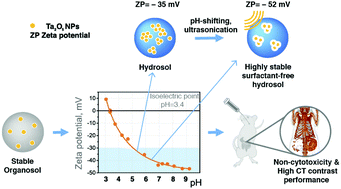Surfactant-free tantalum oxide nanoparticles: synthesis, colloidal properties, and application as a contrast agent for computed tomography†
Abstract
With the growing interest of the medical industry in biocompatible nanoparticles (NPs), the current synthetic methods should be adapted to appropriate demands (toxicity, scalability, etc.). Most applications require colloidal systems to be stable not only in water but also in vivo, which represents a major challenge. In this study, biocompatible Ta2O5 NPs were synthesized by a solvothermal method avoiding toxic reagents, and surfactant-free stable hydrosols were obtained and used for computed tomography (CT) imaging. The small hydrodynamic size (2 nm) and colloidal stability of primary NPs were studied by dynamic light scattering (DLS). The particles were characterized by X-ray diffraction, transmission electron microscopy, energy-dispersive X-ray spectroscopy, and Brunauer–Emmett–Teller analysis to confirm their structure and purity. To develop a stable hydrosol preparation protocol, the influence of pH and ultrasonication duration on the stability of Ta2O5 sols was analyzed by DLS and microelectrophoresis. To enhance the understanding of NP behavior in vivo, sol stability in conditions close to physiological (NaCl solutions) was studied in a pH range of 3–9. Hydrosols prepared by the proposed protocol were stable for at least 6 months and exhibited negligible cytotoxicity. Ta2O5 NPs also showed high CT contrast both in theoretical calculations and in vivo (rat gastrointestinal tract).



 Please wait while we load your content...
Please wait while we load your content...